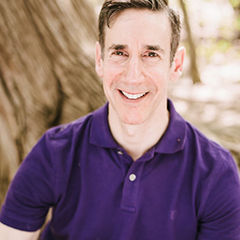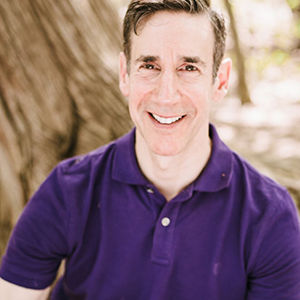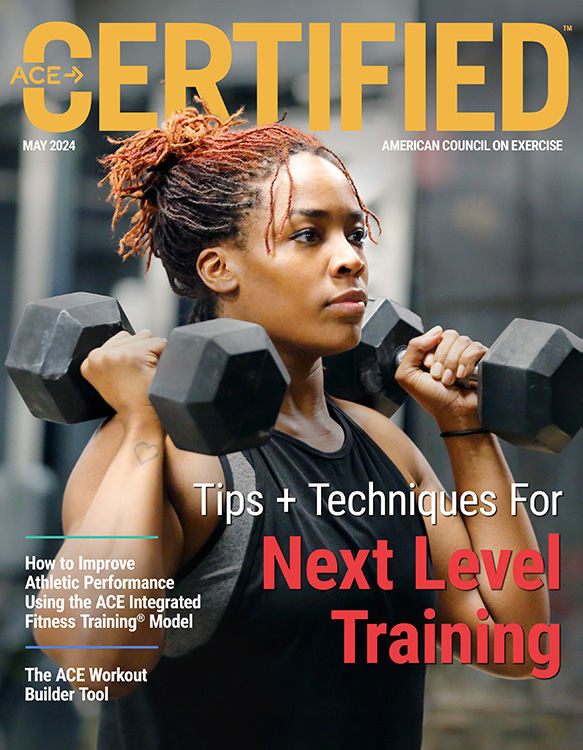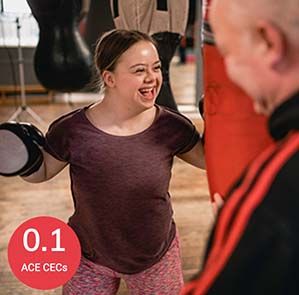
As a health and exercise professional, you likely got into this industry, at least in part, because you have a desire to serve others. You also understand the importance of regular physical activity to overall health—and not just for some, but for everyone. That’s why you are so important to answering the call to expand the fitness industry’s capabilities to effectively serve clients with disabilities, whether physical, developmental, emotional or neurodiverse. As one of the most underrepresented groups in fitness, individuals with disabilities deserve focused attention and support. With the fitness industry moving toward greater diversity, inclusion and barrier-free access, personal trainers, health coaches and other exercise professionals are uniquely equipped to spearhead this transformative movement, changing attitudes and enhancing lives.
Fitness for Everybody (and Every Body)
Peter Morel, founder and owner of Top Shape Fitness Studio in Ottawa Ontario, Canada, has answered this call. A long-time advocate for inclusivity in the fitness industry, Morel’s leadership in promoting fitness for “every body” was born out of his own experience in trying to create a more equitable gym experience for people with disabilities.
“When I approached management at the gym where I worked about adding adapted fitness equipment, I was told that it was too expensive relative to the few people who would be using them,” says Morel, who subsequently felt compelled to pivot his strategy from machine to man. He recognized that change should come not from the top down, but from the bottom up; not from the corporate level, but the ground level, with personal trainers themselves. “I realized that a far better approach was to focus on trainers instead of on machines.”
As a result, Morel set out to educate personal trainers on how to create adapted fitness workouts for clients with disabilities. As Morel sees it, having trainers on staff who are skilled in working with people with disabilities is a win-win situation. Club members living with a disability benefit from having access to a trainer who understands their individualized needs and situation, and the club benefits by being able to market itself to the disability community and bring new business into the gym.
The Importance of Education and Collaboration
Creating awareness within the fitness industry of the value of reaching out to people with disabilities is also the goal and mission for Devon Palermo, owner of DPI Adaptive Fitness in Fairfax, Va. “It’s a passion of mine,” says Palermo. “I’m all for inclusion, and the disability community is a growing niche in the fitness field.”
One of the industry’s most vocal proponents of adaptive fitness and personal training, Palermo got his start as a physical therapy assistant, which gave him a solid background in rehab sciences and motivated him to eventually open up his own full-service adapted gym. There, he offers one-on-one personal training and both large- and small-group fitness classes.
“We need more trainers doing this kind of work, and these days more trainers are showing interest in wanting to work with people with disabilities,” Palermo explains. He believes that education is key in preparing his trainers to confidently and competently work with people with disabilities, so he developed the Adapted Fitness Specialist online course, which is offered through the MedFit Network. (Note: Credit approval for ACE CECs is currently pending.) It teaches the skills and abilities to safely and effectively initiate adaptive fitness programs for those living with, or recovering from, a physical disability or disease.
“Trainers also need to know where their clients have been in terms of their rehab experience, progress and development, and need to know what skill level their client performed at before starting any adapted personal training/group fitness," explains Palermo. That’s why trainers at DPI Adaptive Fitness work closely with their client’s rehab team (physicians, physical therapists and other specialists) for proper guidance and appropriate client background information.
Given its emphasis on education and training, it’s not surprising that DPI Adaptive Fitness has developed a positive reputation and following, so much so that a former client of Palermo’s worked with him on a fundraising campaign to develop a community-based adapted fitness program at no cost to participants. The result is Adaptive Fitness Legion, a non-profit organization that provides funding to support free open-gym sessions and free in-person and online adaptive fitness classes in partnership with DPI Adaptive Fitness.
Personalized Programming is Key
While Palermo’s passion for what he does is solidly anchored on the East Coast, the West Coast is home to an equally passionate advocate of inclusive fitness: Megan Williamson. Founder and owner of the Vancouver-based Ocean Rehab and Fitness, Megan is making waves as another one of Canada’s leading experts on fitness for people living with disabilities. Like Morel and Palermo, Williamson’s migration to adapted personal training was born out of a realization that a huge gap existed in providing workout opportunities for people with disabilities.
“There was no bridge for the client who was just discharged from a rehab facility or a rehab program but was not yet ready to exercise independently,” explains Williamson. “There is either strength training during acute rehab or strength training for para-Olympic athletes. But what about people in the middle? The vast majority of people who are discharged from rehab are left on their own without any guidance on how to train safely and effectively.” This, she says, is why she started her company.
Although people living with disabilities are often grouped together, Williamson is quick to point out the importance of tailoring programs to the specific needs of the individual. “There is no cookie cutter way to train people living with disabilities because everyone’s physical or developmental disability is different.”
Over the past 15 years, Williamson created an environment in which clients can train safely with confidence, pride and purpose. Working out of a community-based research facility known as PARC (Physical Activity Research Centre), she leads one-on-one personal-training sessions for clients enrolled in research studies through the International Collaboration on Repair Discoveries (ICORD). She also offers an online adapted fitness program called Ocean Insider Club that features exercise programs for people with disabilities.
And for those who are inspired by Williamson’s vision to become an adaptive personal trainer, she has developed online education programs that focus on training clients with seven different disabilities and covers topics such as effective methods of assessment, use of adaptive equipment, exercise guidelines for different disabilities, and the psychology of working with people with disabilities.
Addressing the Fear Factor
Jess Silver has devoted her life to working with others who have disabilities. As a certified personal trainer who lives with cerebral palsy (CP), Silver has dedicated her career to being a role model for other trainers who are interested in working with people who have disabilities but don’t know how or where to start serving this clientele.
“I don’t see enough trainers who work with people with disabilities,” explains Silver. She also finds the visible lack of people with disabilities in the gym to be problematic, as well.
“What I see in people with disabilities is their fear to start exercising, and I understand that too,” she states. “Socially, there is a fear of looking different than other gym members that keeps people with disabilities away from the gym. And given that almost all trainers are unfamiliar with how to work with people with disabilities, there is a fear of working with a trainer who has little or no education, background and experience in this area.”
This, explains Silver, is why she became a personal trainer. “I have a dual responsibility,” she says, “to be a leader to others with disabilities and to educate personal-training professionals on how to work with people with disabilities.” In 2017, she created Flex for Access to bring awareness of CP specifically within a fitness context. Its mission, as stated on the website, is to “allow all individuals regardless of limitations, fitness level and interest, the ability to be engaged in exercise and sport.” Through her organization, Silvers raises funds to facilitate adaptive fitness training sessions, purchases equipment for participating fitness facilities and educates personal trainers on how to work with people with disabilities. “I wanted to create a campaign where an understanding of CP is [derived] from a place of movement and sport. It’s about redefining CP from an abilities perspective,” she says.
Silvers’ personal fitness routine has also fueled her passion for challenging assumptions about disability and exercise. Training at her gym at a high-performance level gave her an understanding of both body biomechanics and the role of mental toughness. “It created both a fierceness and thirst in me to continually train and improve and to educate others on its importance.” Today, Silvers has become a sought-after speaker and frequently consults on how to create more inclusive spaces for people with disabilities.
Creating Spaces Where Everyone is Welcome
Creating inclusive spaces is, in fact, a topic near and dear to Tam Kliewer, General Manager of the Goodlife Fitness club in Barrie, Ontario Canada. “Not enough is being done to create a welcoming and inclusive environment on the club level,” asserts Kliewer, who believes some trainers may be fearful of working with clients who have disabilities. “The percentage of people [in the U.S.] living with a disability is 27.2% of the population,” she explains, and there simply isn’t enough exercise professionals who are knowledgeable about working with clients with disabilities. “That’s a huge ratio gap,” Kliewer continues. “Keeping the ratio so wide perpetuates stereotypes and maintains the bias against training people with disabilities.”
The solution, she believes, starts with education. Everyone in the fitness industry needs to become more knowledgeable about disabilities, which will, in turn, make them more open to working with people with disabilities. Fortunately, more and more education and courses are being developed to meet these needs. In addition to the resources mentioned and linked to earlier in this article, ACE offers several courses related to adaptive training and increasing inclusivity within the fitness industry, including Adaptive Fitness Exercise Programming, Adaptive Fitness for Clients With Special Needs, Special Olympics Inclusive Fitness Training and Taking Action With ACE: Practicing Equity, Diversity and Inclusion as a Health and Exercise Professional.
We Need to Talk
Finally, several of the individuals we spoke to cited the need for more open discussions on issues related to disability—and less fear. As Kliewer says, “When something is taboo, we don’t talk about it and that builds up fear.”
Lynne Brick agrees. As co-owner and operator with her husband Victor of 70 Planet Fitness gyms throughout the U.S., Brick argues that we need more conversations about what clubs are doing to promote adapted fitness. “The industry needs to embrace this,” asserts Brick. “We need more trainers who have backgrounds in adaptive training.”
Perhaps no one can offer better perspective on this topic than individuals who are themselves living with some form of disability. But, perhaps the best advice comes from wheelchair athletes who offer prospective adaptive personal trainers a first-person lens on what’s most important to keep in mind when pursuing this career direction.
Candice Combdon is a para-athlete and a motivational speaker. She urges health and exercise professionals, “Don’t be afraid to ask your client about their condition and what they can and can’t do. And do your research. Look for how conventional exercises can be adapted and modified,” she adds.
Veteran wheelchair athlete Angelo Paco seconds this piece of advice. “Get ready to experiment and think outside the box. For example, experiment with different angles of movement when exercising with your client. And start slow and gradually build,” he suggests.
The final word comes from Jordan LaTorre, an adaptive personal trainer in Oro-Medonte, Ontario, Canada, who sums it up perfectly when he says, “If you’re looking to become an adaptive personal trainer, everyone, regardless of ability, can be an athlete. So, train them like one.”
Expand Your Knowledge
Adaptive Fitness Exercise Programming
This course provides practical knowledge and tools that you can immediately begin using to positively impact the well-being of people with special needs—increasing their independence, improving their quality of life, enhancing their health profiles, and boosting their confidence. This course is heartfelt, client-focused and digs deep into understanding all aspects of how people with special needs think, feel, move, and function on all levels: both physically and emotionally.
Adaptive Fitness for Clients with Special Needs
In this video training, you will learn how to lead a client with developmental and/or physical delays through a personal training or small group exercise session. You will discover creative and fun ways to engage and motivate clients in warm-ups, strength training and cardio workouts using various equipment, tools and communication methods.





 by
by 




